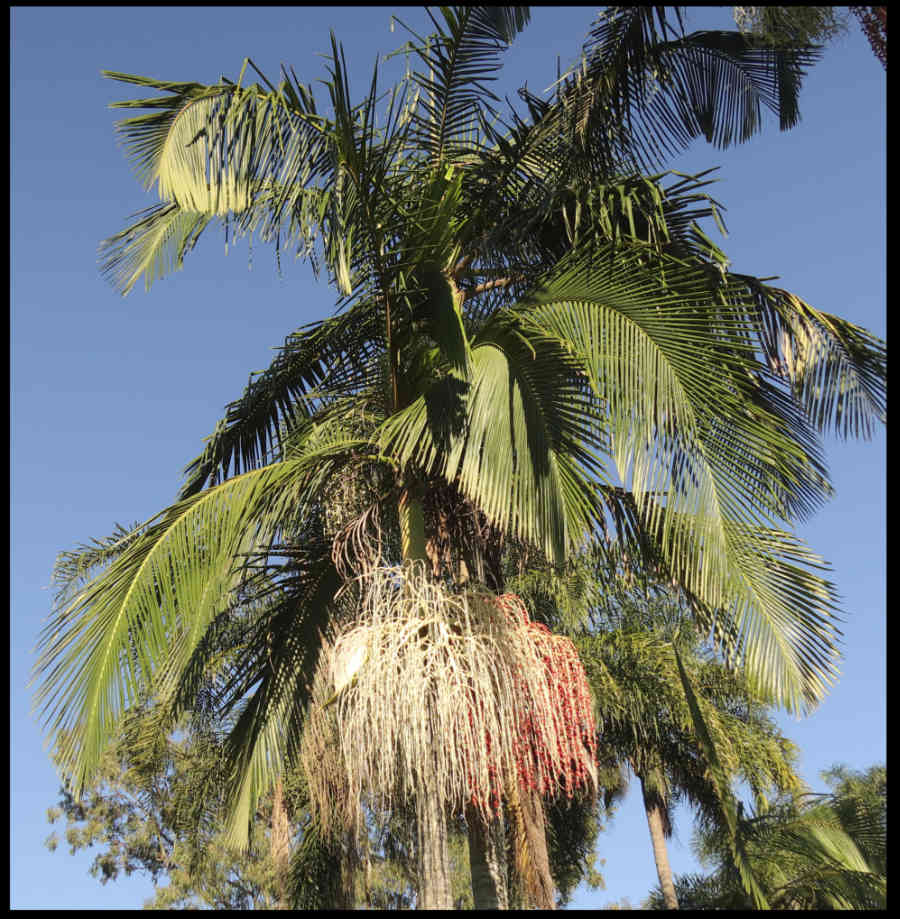There are 6 species with 2 endemic in eastern Australia including 1 in S. E Queensland.
The solitary palms, 15 to 25 m high have a thin grey columnar stem up to 30 cm across.
The base can be slightly to markedly swollen.
Leaf scars tend to be marked at the top of the stem and fainter lower down.
The distance between the sometimes raised scars is very variable.
The erect or arching pinnate (once divided) leaves, up to 4.5 m long are concentrated in the crown.
They are on a short petiole that is grooved on the upper surface and rounded below.
The overlapping leaf sheaths form a green, purplish or brownish crownshaft.
The crownshaft, around 1 m long may be swollen at the base.
The blade midrib (rachis) is covered in tiny brown spots and large scales with a stalk at one end.
There are up to 80 long narrow leaflets (pinnae) with pointed tips on each side.
Leaflets are dark green on the upper surface and pale underneath due to silvery scales.
Leaflets are in 1 plane but the midrib twists up to 90 degrees from around the middle to the tip.
Inflorescences are axillary but, when open are at the base of the crownshaft.
This is because inflorescences open after the leaf has fallen.
The panicles 40 to 50 cm long, are branched 3 or 4 times.
Young inflorescences are protected by bracts (spathes).
The bottom or outer is the tubular prophyll that has a keel on each side.
The peduncular bract/s are smaller and have no keels.
The short, erect to horizontal peduncle has numerous pendulous branches (rachillae).
There are small pointed bracts at the base of the branches.
Branches have groups of 3 spirally arranged flowers.
The central female and lateral males each have short rounded bracteoles at the base.
Flowers, with parts in 3’s are cream, yellow, pink or purplish.
The male flowers have 3 free, overlapping wide ovate sepals with a keel.
The 3 free, much longer petals are narrower with thick pointed tips.
The 9 to 15 (24) stamens have long dorsifixed anthers that open sideways.
The sterile pistillode can be as long as the stamens.
The smaller ovoid female flowers have 3 free overlapping sepals.
The 3 petals are free and overlap except at the tip.
There are 3 (4) staminodes in a group beside the ovary.
The roughly ovoid ovary has 1 ovule in the single locule.
The 3 stigmas, on almost no style curve back.
The fruit are a drupe, up to around 2.5 cm long that matures from green to pink then red.
It is spherical or slightly elongated with thick fibres in the thin fleshy layer.
The single layer of fibres, running lengthwise branch slightly.
There is a single seed.
J.F.


